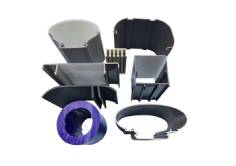China custom plastic injection factorybelieves that there are many factors that affect the shrinkage of thermoplastics. Due to the volume change caused by crystallization during the molding process, the internal stress is strong, and the residual stress frozen in the plastic is large. Due to strong molecular orientation and other factors, compared with thermosetting plastics, the shrinkage rate is larger, the shrinkage range is wide, and the directivity is obvious. In addition, the shrinkage rate after molding, annealing or humidity conditioning is generally higher than that of thermosetting plastics.
When the injection-molded part is formed, the outer layer of the molten material contacting the surface of the cavity is immediately cooled to form a low-density solid shell. Due to the poor thermal conductivity of plastic, the inner layer of the plastic is slowly cooled to form a high-density solid layer with large shrinkage. Therefore, the wall thickness, slow cooling, and high-density layer thickness shrink. In addition, the presence or absence of inserts, and the layout and number of inserts directly affect the direction of the material flow, the density distribution, and the shrinkage resistance, so the characteristics of the plastic parts have a greater impact on the shrinkage size and directionality.

Plastic Injection Profiles
When injection molding manufacturers produce plastic injection profiles, factors such as feed inlet form, size, and distribution directly affect the flow direction, density distribution, pressure holding and shrinking effects, and molding time. Direct feed inlets and feed inlets with large cross-sections (especially thicker ones) have smaller shrinkage but greater directivity, while those with shorter feed openings and shorter lengths have less directivity. Close to the inlet or parallel to the flow direction, the shrinkage is large.
Molding conditions: The mold temperature is high, the molten material cools slowly, the density is high, and the shrinkage is large. Especially for the crystal material, the shrinkage is greater because of the high crystallinity and large volume change. The mold temperature distribution is also related to the internal and external cooling and density uniformity of the plastic part, which directly affects the shrinkage and directionality of each part. In addition, holding pressure and time also have a large impact on shrinkage. Therefore, adjusting mold temperature, pressure, injection speed and cooling time during molding can also appropriately change the shrinkage of plastic parts.
According to the shrinkage range of various plastics, the thickness of the plastics, the shape of the plastics, the size and distribution of the feed port, the injection mold manufacturers determine the shrinkage of various parts of the plastics according to experience, and then calculate the cavity size.
What are the negative effects of excessive temperature on injection molded parts?
During the processing of custom plastic injection profiles, too high or too low temperature will adversely affect the molded plastic parts, which will directly lead to the scrap of the molded plastic parts, so the temperature control in the injection molding process is very important. When the injection molding temperature is too high, the viscosity of the oil will decrease, and leakage may increase. At this time, the volumetric efficiency of the pump and the efficiency of the entire system will be significantly reduced.
If the viscosity of the oil decreases, the oil film of moving parts such as the slide valve will become thinner or the phenomenon of slope cutting will occur. At this time, the friction resistance will also increase, which will increase the wear phenomenon. If the injection molding process is heated too high, it will accelerate the oxidative deterioration of the oil, resolve the asphalt material, and reduce the service life of the hydraulic oil. The resolved material will block the damping orifice and the gap-type valve port, which will cause the pressure valve to jam and not work Metal pipes are elongated and bent, and even cracked.
If the temperature of the injection molding process is too high, the working quality of the injection molded parts will be deteriorated, and the dissolved air in the oil will escape and air pockets will appear, reducing the working performance of the hydraulic system. Hydraulic components with different coefficients of thermal expansion have to become smaller and become stuck in cooperation with the trainee, which will cause work failure, seriously affect the transmission accuracy of the hydraulic system, and cause the work quality of injection-molded parts to deteriorate.
Excessive temperature in injection molding is disadvantageous for injection molded parts. So for injection molding staff, during the processing, we must always pay attention to the temperature of the injection molding machine, and strictly follow the original set temperature for production and processing.